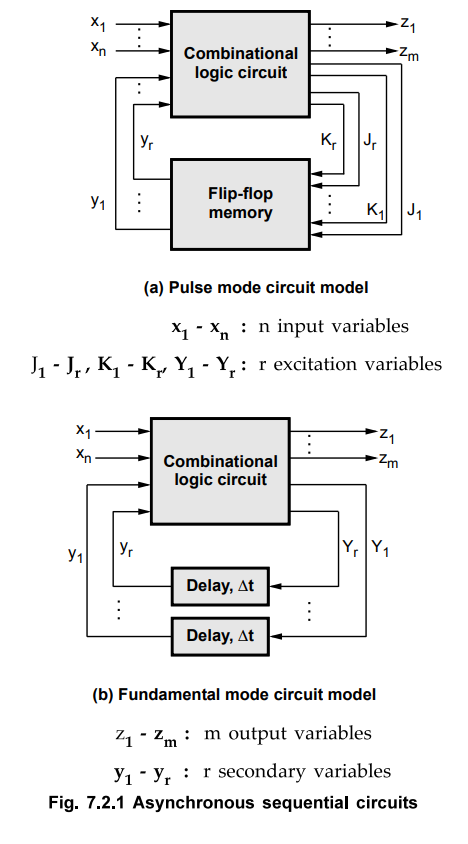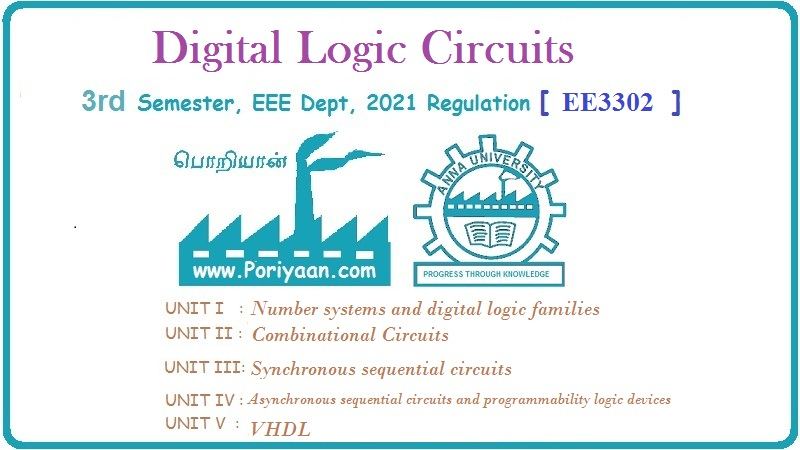Digital Logic Circuits: Unit IV: (a) Asynchronous Sequential Circuits
Types of Asynchronous Circuits
The present state and next state variables in asynchronous sequential circuits are called secondary variables and excitation variables, respectively.
Types of Asynchronous Circuits
Dec.-03,
06, 12, 15
•
Fig. 7.2.1 shows the block diagram of an asynchronous sequential circuit. It
consists of a combinational circuit and delay elements connected to form
feedback loops. As shown in the Fig. 7.2.1, there are n input variables, m
output variables, and k internal states. The delay elements provide a short
term memory for the sequential circuit. The present state and next state
variables in asynchronous sequential circuits are called secondary variables
and excitation variables, respectively.

•
When an input variable changes in value, the secondary variables, i.e. y1
y2, … yr do not change instantaneously. Certain amount of
time is required for the input signal to propagate from the input terminals
through the combinational circuit and the delay elements. The combinational circuit
generates Y excitation variables which gives the next state of the circuit. The
excitation variables are propagated through delay elements to become the new
present state for the secondary variables, i.e. y1 y2, …
yr In the steady state condition excitation and secondary variables
are same, but during transition they are different. In other words we can say
that, for a given value of input variables, the system is stable if the circuit
reaches a steady state condition with yi = Yi. for i =
1,2,-”,r; otherwise the circuit is in a continuous transition and is said to be
unstable.
•
To ensure proper operation, it is necessary for asynchronous sequential circuit
to attain a stable state before the input is changed to a new value. Because of
unequal delays in the wires and gate circuits, it is impossible to have two or
more input variables change at exactly same instant. Therefore, simultaneous
changes of two or more input variables are usually avoided. In other words, we
can say that only one input variable is allowed to change at any one time and
the time between two input changes is
kept longer than the time it takes the circuit to reach a stable state.
•
According to how input variables are to be considered, there are two types of
asynchronous circuits :
*
Fundamental mode circuits and
*
Pulse mode circuits.
Fundamental
mode circuit
It
assumes that :
•
Input changes should be spaced in time by at least At, the time needed for the
circuit to settle into a stable state following an input change. That is, the
input variables should change only when the circuit is stable.
•
Only one input variable can change at a given instant of time and
•
Inputs are levels and not pulses.
•
Delay lines are used as memory elements.
Pulse
mode circuit
It
assumes that :
•
The input variables are pulses instead of levels.
•
The width of the pulses is long enough for the circuit to respond to the input.
•
The pulse width must not be so long that it is still present after the new
state is reached.
•
Pulses should not occur simultaneously on two or more input lines.
•
Flip-flops are commonly used as a memory elements.
•
Memory element transitions are initiated only by input pulses.
•
Input variables are used only in the uncomplemented or the complemented forms,
but not both.
Review Questions
1. What is a fundamental mode asynchronous sequential circuit ?
2. Illustrate pulse mode asynchronous circuit.
AU : Dec.-06, Marks 8
3. Sketch the block diagram of an asynchronous sequential
circuit.
4. Compare pulsed mode and fundamental mode asynchronous
circuit.
Digital Logic Circuits: Unit IV: (a) Asynchronous Sequential Circuits : Tag: : - Types of Asynchronous Circuits
Related Topics
Related Subjects
Digital Logic Circuits
EE3302 3rd Semester EEE Dept | 2021 Regulation | 3rd Semester EEE Dept 2021 Regulation
